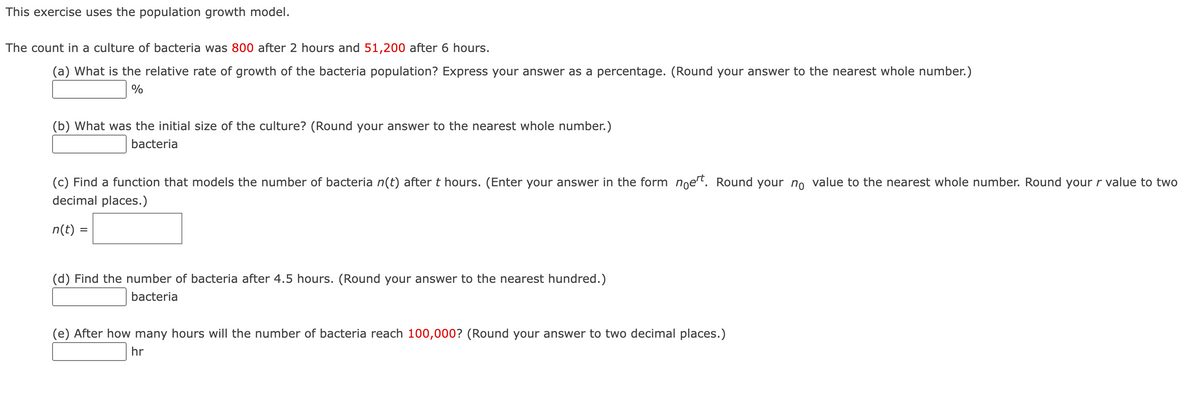The count in a culture of bacteria was 800 after 2 hours and 51,200 after 6 hours. (a) What is the relative rate of growth of the bacteria population? Express your answer as a percentage. (Round your answer to the nearest whole number.) % (b) What was the initial size of the culture? (Round your answer to the nearest whole number.) bacteria (c) Find a function that models the number of bacteria n(t) after t hours. (Enter your answer in the form noet. Round your no value to the nearest whole number. Round your r value to two decimal places.) n(t) =
The count in a culture of bacteria was 800 after 2 hours and 51,200 after 6 hours. (a) What is the relative rate of growth of the bacteria population? Express your answer as a percentage. (Round your answer to the nearest whole number.) % (b) What was the initial size of the culture? (Round your answer to the nearest whole number.) bacteria (c) Find a function that models the number of bacteria n(t) after t hours. (Enter your answer in the form noet. Round your no value to the nearest whole number. Round your r value to two decimal places.) n(t) =
Glencoe Algebra 1, Student Edition, 9780079039897, 0079039898, 2018
18th Edition
ISBN:9780079039897
Author:Carter
Publisher:Carter
Chapter7: Exponents And Exponential Functions
Section7.8: Transforming Exponential Expressions
Problem 4PPS
Related questions
Question
This exercise uses the population growth model.
The count in a culture of bacteria was 800 after 2 hours and 51,200 after 6 hours.

Transcribed Image Text:This exercise uses the population growth model.
The count in a culture of bacteria was 800 after 2 hours and 51,200 after 6 hours.
(a) What is the relative rate of growth of the bacteria population? Express your answer as a percentage. (Round your answer to the nearest whole number.)
%
(b) What was the initial size of the culture? (Round your answer to the nearest whole number.)
bacteria
(c) Find a function that models the number of bacteria n(t) after t hours. (Enter your answer in the form noe". Round your no value to the nearest whole number. Round your r value to two
decimal places.)
n(t) =
(d) Find the number of bacteria after 4.5 hours. (Round your answer to the nearest hundred.)
bacteria
(e) After how many hours will the number of bacteria reach 100,000? (Round your answer to two decimal places.)
hr
Expert Solution
This question has been solved!
Explore an expertly crafted, step-by-step solution for a thorough understanding of key concepts.
This is a popular solution!
Trending now
This is a popular solution!
Step by step
Solved in 2 steps with 3 images

Recommended textbooks for you

Glencoe Algebra 1, Student Edition, 9780079039897…
Algebra
ISBN:
9780079039897
Author:
Carter
Publisher:
McGraw Hill

Big Ideas Math A Bridge To Success Algebra 1: Stu…
Algebra
ISBN:
9781680331141
Author:
HOUGHTON MIFFLIN HARCOURT
Publisher:
Houghton Mifflin Harcourt

College Algebra (MindTap Course List)
Algebra
ISBN:
9781305652231
Author:
R. David Gustafson, Jeff Hughes
Publisher:
Cengage Learning

Glencoe Algebra 1, Student Edition, 9780079039897…
Algebra
ISBN:
9780079039897
Author:
Carter
Publisher:
McGraw Hill

Big Ideas Math A Bridge To Success Algebra 1: Stu…
Algebra
ISBN:
9781680331141
Author:
HOUGHTON MIFFLIN HARCOURT
Publisher:
Houghton Mifflin Harcourt

College Algebra (MindTap Course List)
Algebra
ISBN:
9781305652231
Author:
R. David Gustafson, Jeff Hughes
Publisher:
Cengage Learning



Algebra & Trigonometry with Analytic Geometry
Algebra
ISBN:
9781133382119
Author:
Swokowski
Publisher:
Cengage